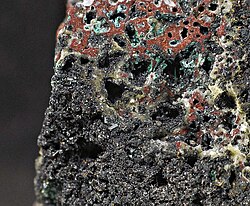| Lyonsite | |
|---|---|
| General | |
| Category | Vanadate mineral |
| Formula | Cu3Fe+34(VO4)6 |
| IMA symbol | Lyo [1] |
| Strunz classification | 8.AB.40 |
| Crystal system | Orthorhombic |
| Crystal class | Dipyramidal (mmm) H-M symbol: (2/m 2/m 2/m) |
| Space group | Pmcn |
| Unit cell | a = 10.29, b = 17.2 c = 4.91 [Å]; Z = 2 |
| Identification | |
| Color | Black; creamy white in reflected light in polished section |
| Crystal habit | As euhedral flattened lath shaped crystals |
| Cleavage | Good on {001} |
| Tenacity | Brittle |
| Luster | Metallic |
| Streak | Dark gray |
| Diaphaneity | Opaque |
| Specific gravity | 4.215 calculated |
| References | [2] [3] [4] |

Lyonsite (Cu 3 Fe +34(V O 4)6) is a rare black vanadate mineral that is opaque with a metallic lustre. It crystallizes in the orthorhombic crystal system. Lyonsite often occurs as small tabular typically well formed crystals. Lyonsite has a good cleavage and a dark gray streak.
Lyonsite occurs as a sublimate in volcanic fumaroles. It is often associated with howardevansite and thenardite. [2] It was first described in 1987 for an occurrence on the Izalco volcano, El Salvador. It was named for mineralogist John Bartholomew Lyons (1916–1998) of Dartmouth College. [3] It has also been reported from a mine dump in the Lichtenberg Absetzer Mine of Thuringia, Germany. [4]